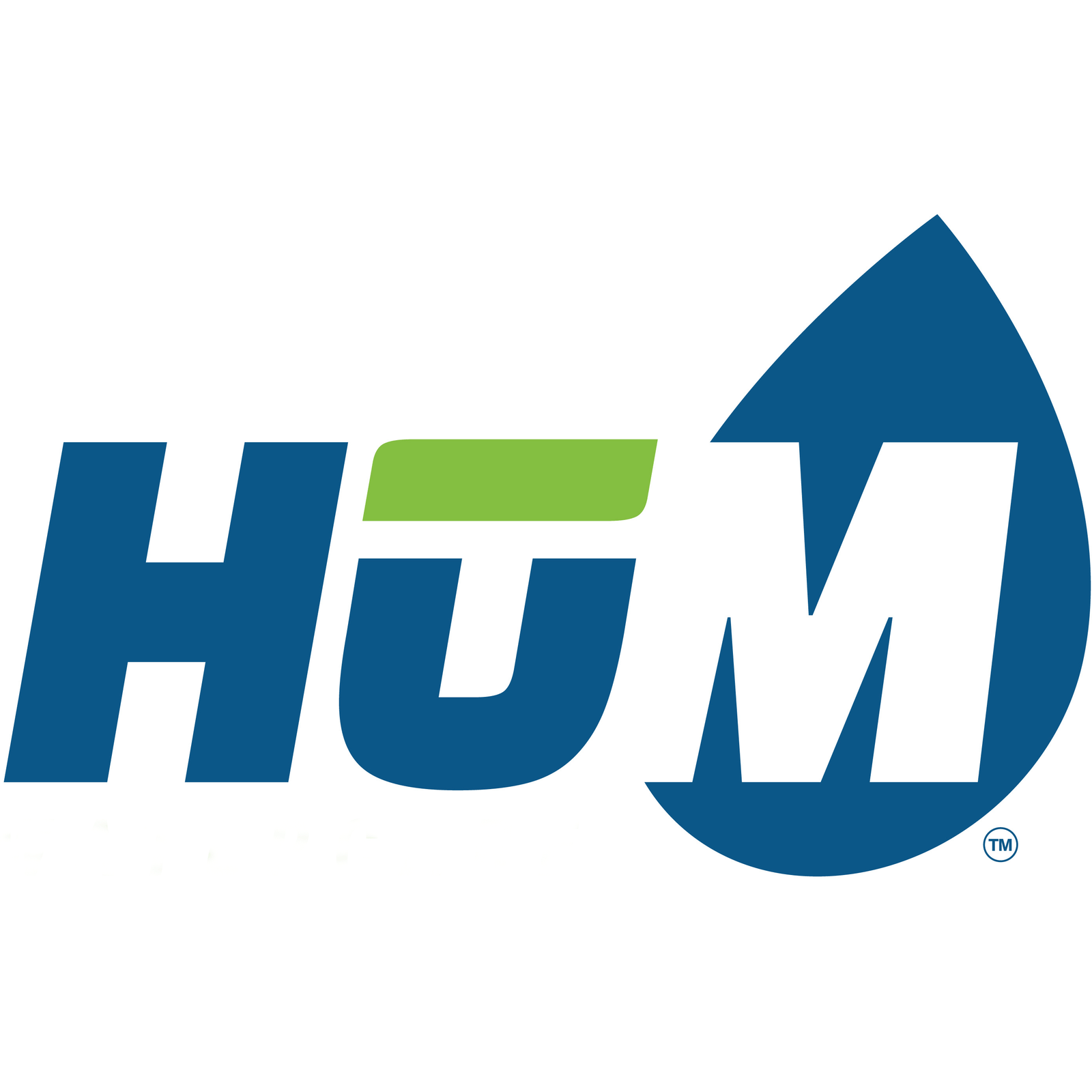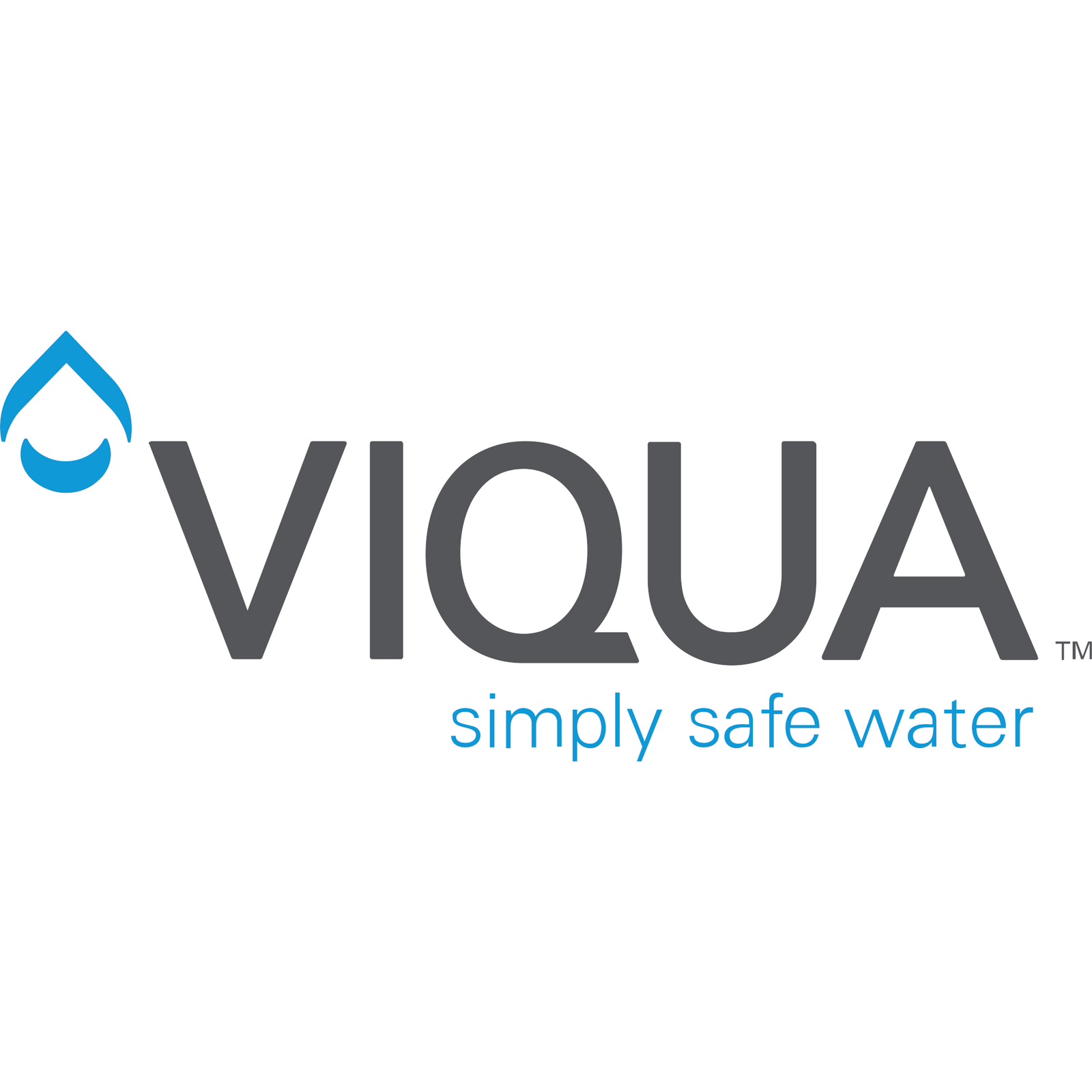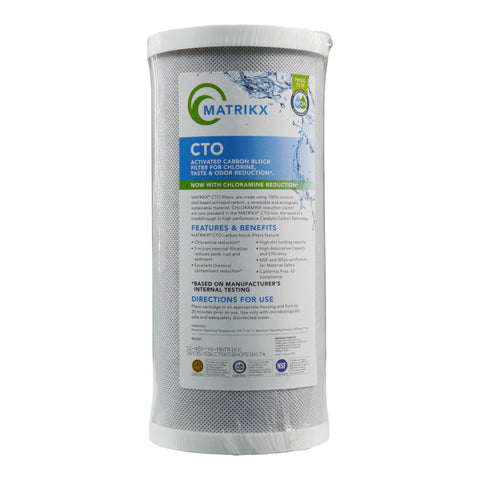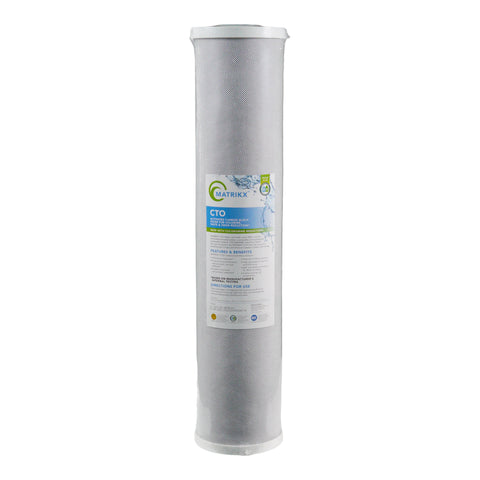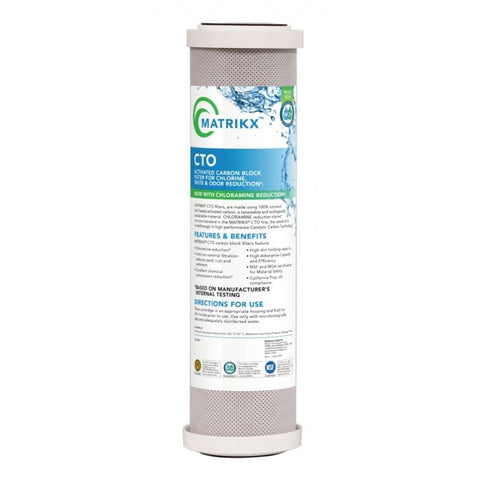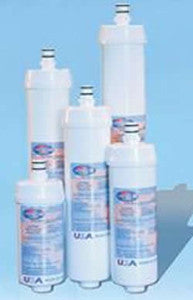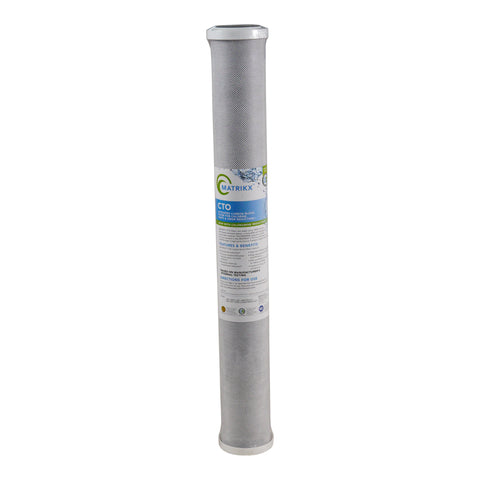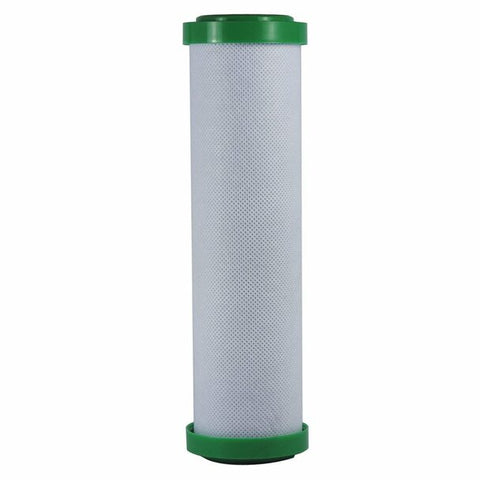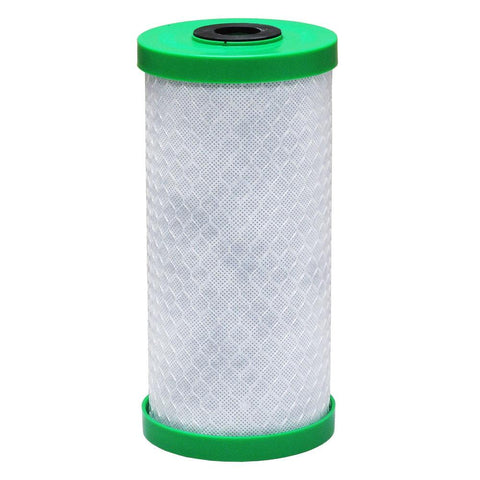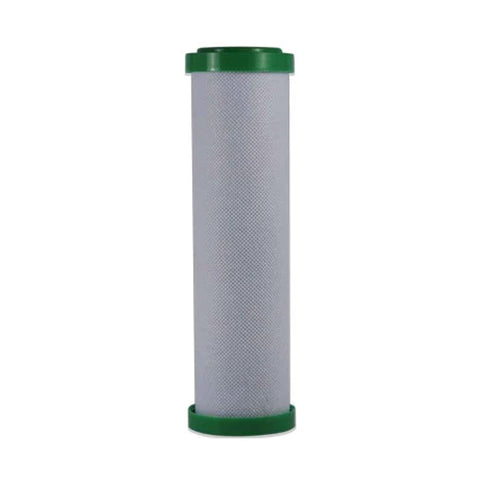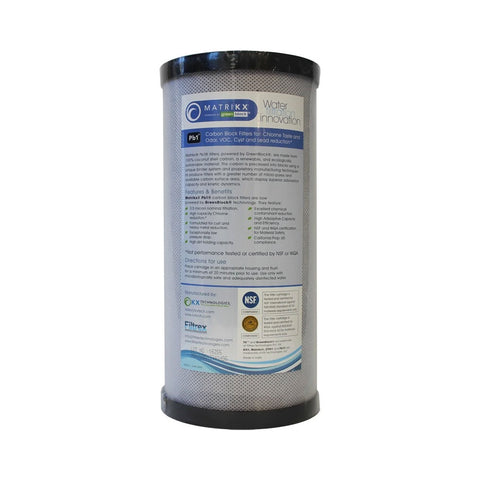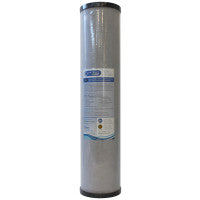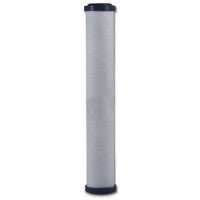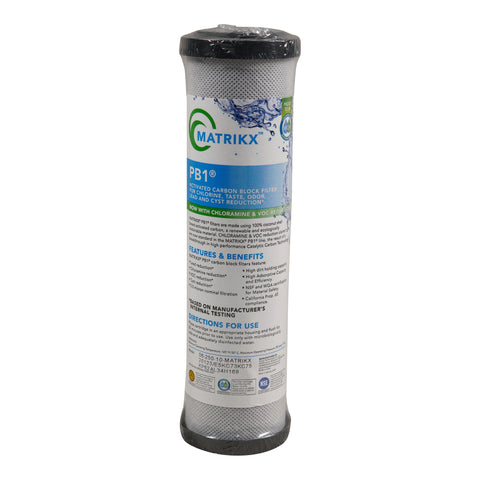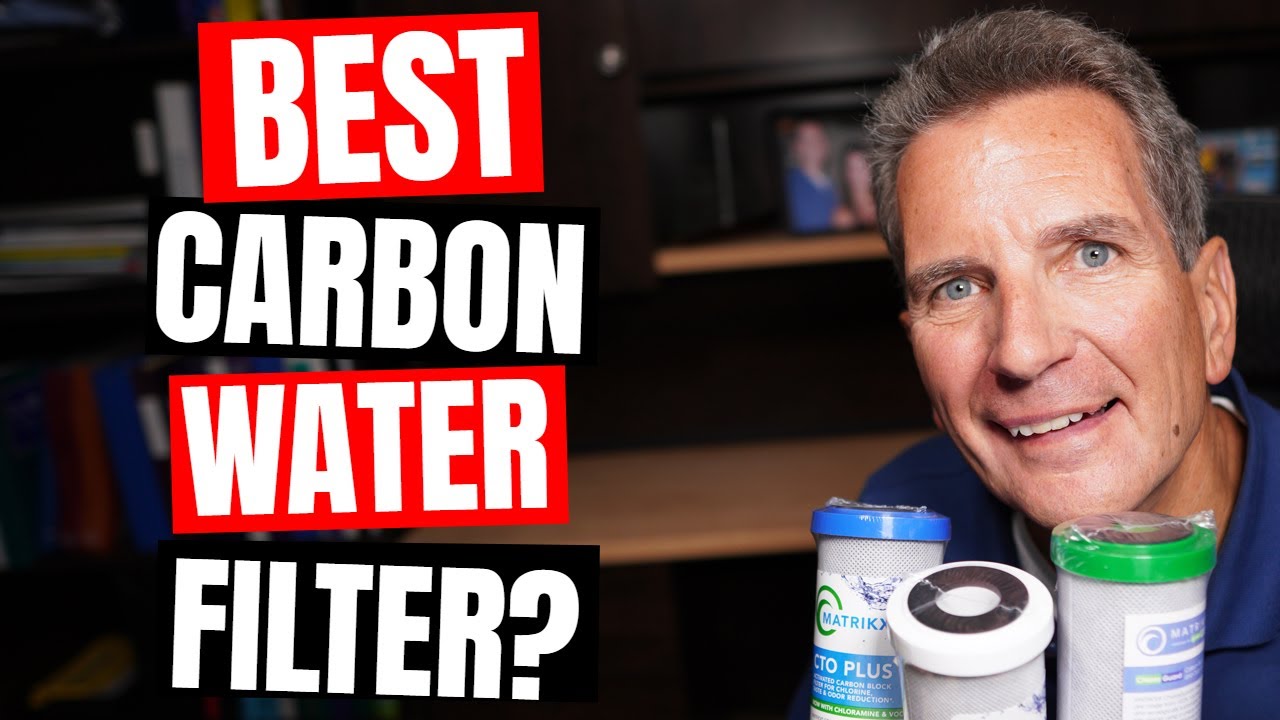
Let's use the carbon filters from KX Matrikx as an example because they have four different carbon filters to choose from. Although all of their filters remove both Chlorine and Chloramines, only some filters remove VOC’s and Lead. Plus, their capacity varies significantly as does pH drop.
Check out the difference between each carbon filter type below to help you choose the best one for your needs!
COMPARING KX MATRIKX CARBON WATER FILTERS

1) CTO Filter: When you need a low cost RO filter.
- The least costly of these Matrikx Carbon filters is the
CTO filter, which is best used in Reverse Osmosis systems and in applications where there wont be much water used or you have concerns about VOC’s, lead or Cysts because the RO membrane will remove those.
- A CTO filter removes chemicals and odour from your water while improving the taste for your family.

2) CTO Plus Filter: When you want more removal capacity with added VOC removal.
- The CTO Plus gives you more than double the capacity of the CTO and also removes Volatile Organic compounds. However, the pressure drop is a little bit more.
- It's the ideal choice for a wide range of residential, food service, commercial and industrial applications.

3) Chloraguard Filter: When you have chloramines in your water instead of chlorine.
- The Chloraguard gives you 50% more chlorine removal capacity than the CTO plus and 100% more Chloramine removal. This is the filter you need to use if your municipality uses chloramines for water disinfection or if you are looking for a large capacity chlorine removal filter.
- It can be used in residential and commercial applications, as well as in food service and pre- and post- RO filter systems.

4) PB1 Filter: When lead and cysts are a concern but you can live with the pressure drop.
- The PB1 does a great job at chlorine and chloramine removal, as well as VOC’s. Plus, add to it lead removal and Cyst removal! But you will lose 12 psi of pressure with this filter and it’s 0.5 microns, so you better make sure you have a 1 micron sediment pre filter to maximize filter life.
- The PB1 water filter is effective is in the reduction of bad tastes & odour, and will reduce cysts.
So, which carbon water filter is best for your family?
If you have questions or need help choosing the best water treatment solutions for you and your family, we're here for you! Reach out to us using the contact form on our website here, or call 705-527-5900 and we'll be happy to help point you in the right direction.
Go here for my next video on water filtration and I’ll see you there!
Video Transcript
Gary The Water Guy:
Carbon filters are known as taste and odor filters. They also remove chemicals from your water, chlorine if you're on municipal water system, herbicides, pesticides, that kind of thing, if you're on well water. Well, if you'd like to know the differences between the different kinds of carbon filters, and there's lots of differences, this video is for you. And I'm going to explain it to you right now.
Gary The Water Guy:
Hi, I'm Gary the Water Guy, and I simplify water filtration to help you conquer crappy water for your family. We're going to take the example of a KX Matrikx. They have four different kinds of carbon filters, and we're going to check them out.
Gary The Water Guy:
So the first one is the CTO. This is the least costly of the bunch. It also it... taste and odor filter, does a lot of good things. And then we'd go up to the CTO Plus, and very soon, we're going to learn what that plus means, and what you get for the extra plus. It removes chlorine, and it also removes chloramines. Then we have the actual chloramine filter. That's another version that they have. And then they've got the Pb1, and the Pb1, again, does a whole bunch of things. Let's look at the specifications so we can understand a little bit more closely what each of these does.
Gary The Water Guy:
All right, so we'll start with a Matrikx CTO, kind of an all-around filter. Let's check the specs on that one. We can see that it's five micron nominal rating. We can see that it's good for 12,000 gallons, at one gallon per minute. We can see that it's about 1,000 gallons of capacity for chloramine removal, and a pressure drop of about three PSI.
Gary The Water Guy:
Moving onto the CTO Plus, we can see that now instead of a five micron rating that CTO was, now it's a one micron rating. So it's a finer filter. We can see that it's good for 30,000 gallons of chlorine removal, significantly more, 2000 gallons of chloramine removal, and now, this one also [inaudible 00:02:00] VOC, volatile organic compounds. Those are basically from industry offshoots of different chemicals that have been put in the water in that over the years. This will also remove 750 gallons of those at 0.5 gallons for an inflow rate. And the pressure drop now is five PSI.
Gary The Water Guy:
So up next is the Chloraguard filter. You'll see from the specifications of that, again, it's a one micron rating, but chlorine reduction capacity is significantly higher than the other two filters. Now we're up to 45,000 gallons, but the Chloraguard filter is actually its claim to fame, or its purpose, is to remove chloramines from your water. And again, so you see, chloramine reduction is up to 4,000 gallons, but this also removes VOC's, volatile organic compounds. So you'll see that... What are volatile organic compounds? It's basically chemicals that have ended up in the water supply from manufacturing, from aerosols, and some gasoline, those kinds of things that are ending up in the water. This will remove that, 750 gallons at 0.5 gallons per minute, and a five PSI pressure drop.
Gary The Water Guy:
And last, but definitely not least, is the KX Matrikx Pb1. Now we compare the specs on that, and you can see that now we're at a 0.5 micron rating. The chlorine reduction capacity is 30,000 gallons, which is quite good. The chloramine is 2000 gallons, not as good as the Chloraguard, but obviously that's its goal. And VOC's 500 gallons at 0.5 gallons per minute, but this one also removes lead. So, again, you can see a quite high rating for that, 3,750 gallons at a relatively 0.75 gallon per minute flow rate. But the pressure drop on this one is significantly higher than the others, 12 PSI. So if you're putting on that kind of a filter, you're going to need to make sure that you put on a one micron sediment filter, something like that, before it, so that the filter doesn't clog prematurely, just from the amount of sediment that might be in your water.
Gary The Water Guy:
So which of these is the best choice for your family? Well, it depends what you're trying to accomplish. If you're just looking for a filter for your reverse osmosis system, and your municipal water system, or well water, something like that, the CTO will do a pretty good job. If you're on a municipal water system that has chloramines in your water, you're probably going to want to upgrade to the Chloraguard. Now, if you're on a well water or something like that, then you probably want to go with the Pb1, because the Pb1 not only is a taste and odor filter, but it's also going to remove lead from the water. It's going to remove VOC's from the water, volatile organic compounds, and it's going to remove cysts. Although the pressure drop on that one's going to be pretty high, 12 PSI, I'd just makes sure that I would precede it by a one micron filter in that reverse osmosis system.
Gary The Water Guy:
Click over here for my next video on water filtration, and I'll see you there.


